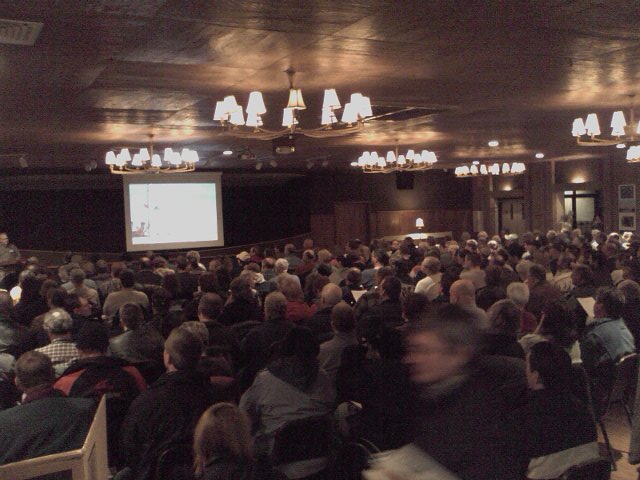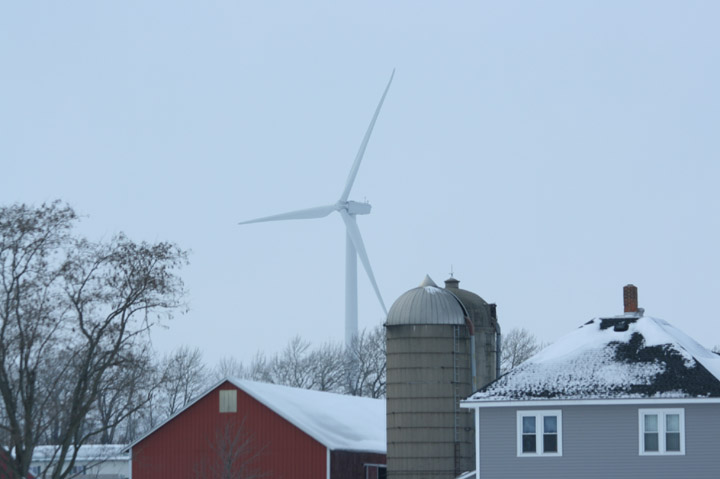Entries in brown county ledge wind (3)
2/19/10 TRIPLE FEATURE: CORRECTION: We were wrong. It was MONROE county not Brown County AND When it comes to the ways of wind developers, the cat that lost its tongue found it on Thursday night in Brown County AND what does it take to come between a father and son? Would you guess a payment from a wind developer? AND Wisconsin wind farm residents are not alone in health complaints
 Concerns about proposed Invenergy project drew capacity crowd to Thursday's BCCRWE meeting
Concerns about proposed Invenergy project drew capacity crowd to Thursday's BCCRWE meeting
Correction: Better Plan was in error when reporting that residents who spoke out against the Invenergy project proposed for Brown County found dead skunks and deer heads on their mailboxes.
The dead skunks and deer heads were found on the mail boxes of those who spoke out against an Invenergy project in Monroe County
Better Plan regrets the error.
Concerns about proposed Invenergy wind project draws capacity crowd to meeting in Brown County
By Lynda Barry
February 20, 2010
KAUKANA- It was standing room only in Van Able's restaurant after residents quickly filled the five hundred seats in the banquet hall and overflowed into a side room.
Community members came to hear concerns about Chicago-based Invenergy's 100 turbine Ledge Wind project which would occupy the Towns of Morrison, Holland, Wrightstown and Glenmore, making it the largest wind development in the state.
The event was organized by a grassroots community organization called Brown County Citizens for Responsible Wind Energy (bccrwe.com) and drew a capacity crowd.
Along with speakers who addressed the now well-known issues of turbine noise, sleep loss, shadow flicker, loss of property value and impacts on farm animals, local residents had the chance to hear about something rarely spoken about in public.
Landowners detailed their first hand experiences with the questionable techniques used by Invenergy to convince them to sign onto the project.
They spoke about being lied to by developers who said their neighbors had signed onto the project when in fact they had not. They spoke about the varying amounts of money offered to different landowners even as Invenergy claimed publicly that all landowners were getting the same amount.
Some landowners talked about about what made them decide not to sign on to the project while others expressed deep regrets about having signed the contracts.
There were several discussions about what options landowners had for getting out of contracts and along with concerns about being sued by the wind company.
Speakers also talked about about the negative impact the proposal has had on the community and spoke about the new hostilities between neighbors and family members.
A speaker from Monroe county mentioned that in his community residents who spoke publicly against the project were soon greeted by dead skunks and deer heads on their mailboxes. Some felt the wounds made to this previously strong community would never heal.
Invenergy representatives were in attendance but did not openly identify themselves and remained quiet throughout the meeting.
More on this story to come.
SECOND FEATURE
Wind farm debate divides families
WBAY-TV, www.wbay.com
by Jeff Alexander
February 17 2010
Plans to build the state’s largest wind farm in southern Brown County is dividing several rural communities. It’s even causing turmoil within families.
For almost a year now, Roland Klug has lobbied his neighbors to join him in signing contracts with a Chicago company to build 400-foot wind turbines on their land in Morrison. As Roland sees it, it’s a sign of the times.
“Some people hate them. I love them. I think it’s progressive. It’s a country moving forward,” Roland said.
But just a mile away is another sign with a very different message put up by Roland’s son, Dave.
Like many families in this farming country, the Klugs are at odds with each other.
“It is very, very trying I will say right now,” Dave said.
As Dave sees it, the prospect of 100 turbines towering over the landscape is appalling. The fact that four could be as close as 1,000 feet from his home is scary, he says.
He points to research he says he’s done on other wind farm developments around the country and the impact on nearby residents.
“Every one we read about are having all kinds of health issues, property values drop, and to me I guess it just doesn’t seem like it’s a real good investment for our community,” Dave said.
But according to Roland, it’s an investment that will help him keep his farm. He’s signed on for two turbines that will pay him $20,000 a year.
Roland says he “had to sell off 48 acres to make a payment for a couple of years, and we’d have to just keep selling off.”
Roland knows he’s made some neighbors angry. “My son gets very mad.”
Dave said, “My son is 21 and was all set to buy some land right by me which would’ve been my dream, been great, but right now we had to put it all on hold. You cross your fingers, but he’s probably going to end up living somewhere else.”
Roland says, “I just know in time it’ll all straighten out, it always does.”
Dave Klug, though, isn’t so sure. Especially if the wind turbines go in.
There is a meeting scheduled for Thursday night called “Living in an Industrial Wind Turbine Project.”
It’s at Van Abel’s in the Town of Holland. Doors open at 6 P.M. and speakers begin at 7.
NEW! CLICK HERE to watch a video about wind farm residents in Australia who describe sleep loss, health problems and other complaints identical to those reported by Wisconsin wind farm residents.
For those with slower internet connections CLICK HERE to read the transcript of the interview
NOTE FROM THE BPWI RESEARCH NERD: People who live in Rock County may be interested in the wind company's response to resident's complaints. Spanish owned Acciona is the same company that now owns the leases to land in the Towns of Magnolia and Union. Better Plan, Wisconsin has contacted Acciona several times to ask about their plans for the community. Acciona has not replied.
 WANT MORE? CLICK HERE TO READ TODAY'S "WIND TURBINES IN THE NEWS"
WANT MORE? CLICK HERE TO READ TODAY'S "WIND TURBINES IN THE NEWS"
2/12/10 The wind developer told us that modern wind turbines are no louder than a refrigerator and "whisper quiet"
1/22/10 Why are our neighbors to the north making noise about turbine noise? And Beavers best Badgers when it comes protecting communities from wind turbine noise limits

Home in a wind farm. Fond du Lac County, Wisconsin. Photo by Gerry Meyer 2009
Government of Ontario requests 'Expert Advice' on Wind Turbine Noise
From THE SOCIETY FOR WIND VIGILANCE
January 20, 2010
TORONTO- The government of Ontario admitted this week that it does not know 'how or whether' to measure for low frequency sound at wind turbine installations.
Two Requests for Proposal www.merx.com were issued yesterday by the Ontario Ministry of Environment to help the ministry in "determining how or whether to regulate low frequency noise emissions from wind turbines".
The requests go on to state, "The Ministry requires a consultant to assist in the development of ameasurement procedure to assess noise compliance of existing wind farms with the applicable sound level limits"
"Unlike typical industrial noise sources, measurement of audible noise from wind turbines in general raises technical challenges."
The request adds, "the MOE Noise Guidelines for Wind Farms, October 2008 do not contain a measurement method for assessing the actual noise impact."
Questions arise:
If the government does not have a method for measuring noise impact, why are they moving ahead with more wind developments before proper studies and science are completed?
How did the Ministry of Environment arrive at an arbitrary distance of 550m from industrial wind turbines to protect from noise?
Reports of adverse health effects experienced by people living too close to industrial wind turbines have been brought to the attention of the Ministry of Environment for more than two years.
Nothing has been done to mitigate the suffering and many have been forced to abandon their homes or be bought out by a wind developer. Hundreds of requests for mitigation of the issue have not been dealt with yet industrial wind turbines continue to be erected.
The Society for Wind Vigilance, an International Federation of Physicians and other professionals, repeats its appeal to all governments including the Government of Ontario to place a moratorium on all wind development until a third party health study is conducted into the impact of industrial wind turbines on human health.
At the minimum, current turbines should be turned off at night as a French court ruled and new industrial wind turbines should be set back a minimum of 2000 meters from residences. Ongoing monitoring for adverse health effects must be conducted.
SECOND FEATURE:
Note from the BPWI Research nerd: The Oregon State noise limit for the Invenergy wind farm mentioned in the following story is 36 dbA
The current turbine noise limit for Invenergy in the State of Wisconsin is 50 dbA
The "too loud" referred to in the story below is under 38dbA
Study says wind farm is too loud
East Oregonian, eastoregonian.com
January 21, 2010
The Willow Creek Energy Center is in violation of state noise standards for at least three nearby homes, its acoustical expert revealed at a planning commission meeting Tuesday night. Still up for debate, according to the other experts in attendance, is how much and how often.
The meeting amounted to a day in court for the neighbors of the wind farm – Dan Williams, Mike and Sherry Eaton and Dennis Wade – who began complaining about farm’s noise and other effects last year.
According to Oregon Administrative Rule, energy-generating facilities can be as loud as 36 decibels at adjacent homes – that’s 26 decibels for background noise plus 10 for the facility. In the analysis of the acoustical expert that Invenergy hired, Michael Theriault of Portland, Maine, the noise at the Wade residence was usually less than 36 decibels. At the Eaton residence, it was usually less than 37 decibels. At the Williams residence, the noise “moderately” exceeded the noise code about 10 percent of the time, Theriault said.
Theriault also conducted a noise study at the home of another neighbor, Dave Mingo, and found that the noise was usually less than 37 decibels. “On overview, the facility is substantially in compliance with state rules,” he said.
Kelly Hossainin – a lawyer for Invenergy, the company that runs Willow Creek Energy Center – argued that the amount by which the wind farm exceeded the noise limit at the Eaton and Mingo residences, one decibel, is not perceptible outside a laboratory environment.
She said the times the wind farm exceeded the noise standards were unusual events, which would qualify for an exception under the rules.
Theriault explained some of his methods to the planning commission. For example, he did not analyze the noise data that was generated while the wind was blowing more than 9 meters per second (about 18 miles per hour). According to General Electric, the company that made the turbines, turbine noise does not increase after that point, he said.
Commissioner Pam Docken asked Theriault if he could speak to the health effects of turbine noise.
“Annoyance is a very complex phenomena,” he said, referring to a recent wind-industry study that found no negative health effects of wind turbines except annoyance. “We know that in some cases, annoyance isn’t even related to noise level. It can be related to whether they see the noise source and can change with the subject’s attitude to the noise source.”
Then Kerrie Standlee, a prominent acoustical expert – he works for the Oregon Department of Energy doing site certification reviews and was even hired by Morrow County to analyze the racetrack issue – began to speak for the Eatons, Williams and Wade. He presented his own noise study, which showed that the noise at the Eaton’s residence hovered just above the noise standard on a regular basis, and at the Williams residence it regularly went above 40 decibels.
Standlee also analyzed Theriault’s study. He pointed out that the wind farm consistently broke the noise rule at precisely the time when Theriault decided not to use the data – when wind speeds exceeded 9 meters per second.
When the data is analyzed in a wider range of wind speeds, he said, the wind farm was in violation of the rule 22 out of 37 nights.
“I’m not sure how someone can say this is an unusual, infrequent event,” he said. “To me, 59 percent is not occasional or unusual.”
Standlee’s noise study also went beyond Theriault’s in that he gave the residents a sheet of paper to log their experiences with time and date. He then overlaid those comments on the data and showed that when the residents reported high noise, the wind was blowing from a particular direction or at a particular speed.
Another acoustical expert, Jerry Lilly, spoke for Dave Mingo. He came up with results similar to Standlee’s, but noted that the Theriault study was also flawed because it did not measure noise at the residence’s property line – as required by Morrow County noise ordinance – and it did not measure the noise inside the homes.
The commission also heard heartfelt testimony from the residents themselves, who said that their lives had been completely changed since the wind farm came.
“A basic right in my life is to live in my beautiful home with my peace and quiet, and now I can’t do that,” Dan Williams said.
When the testimony ended, the planning commission agreed to wait until their next meeting to make a decision about whether – and how – the Willow Creek wind farm must mitigate the noise problem.